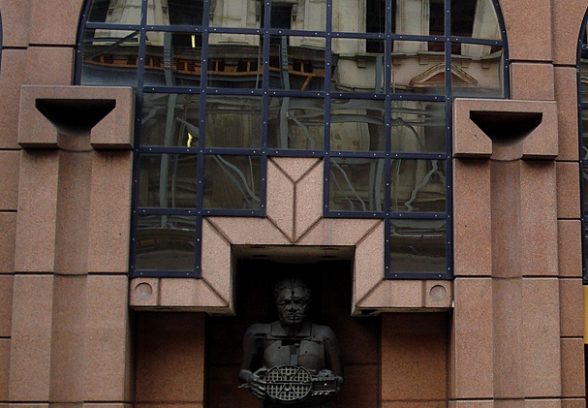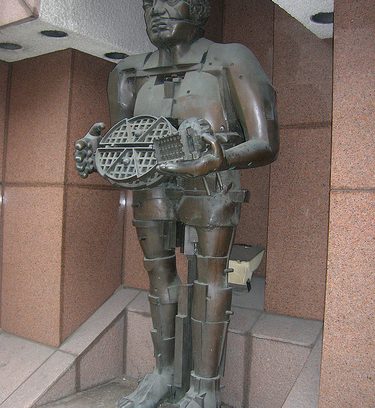This website uses cookies
This website uses cookies to enable it to function properly and to analyse how the website is used. Please click 'Close' to accept and continue using the website.




A giant bronze statue by Sir Eduardo Paolozzi that has been on public display in central London for 25 years is due to be sold at auction next month. The work entitled “The Artist as Hephaestus”, designed for the facade of an office building at 34-36 High Holborn at pavement level is still in place today, but is set to be sold to the highest bidder on 14 November.
The Twentieth Century Society is urging Camden Council to take immediate action to ensure this important work of modern sculpture remains visible to the public.
Sir Eduardo Paolozzi (1924-2005) was one of Britain’s leading twentieth century artists and sculptors with examples of his work in many art galleries and museums around the world. Very few are in the public realm, and this giant bronze commission is of particular interest as a self-portrait of the artist depicted as Hephaestus.
Hephaestus – the Greek god of metallurgy, volcanoes, sculptors, blacksmiths, and craftsmen – was known for building bronze self- operating machines or automatons to work for him. This statue was created at a time when much of Paolozzi’s work focused on the fusion of man and machine, and robotic creatures for which he became famous
The figure is depicted walking, appearing to emerge from the building carrying two sieve like objects, with the larger sieve made from parts reportedly from a used washing machine. This monumental statue constructed of bronze, 2.5 m in height has been on prominent display at street level since it was created in 1987.
Two smaller preliminary models related to this piece were on display at the Royal Academy Summer Exhibition in 1987. One was subsequently bought by the National Gallery, the other sold at auction in 2006. The life sized plaster and polystyrene model of this statue is owned by the National Portrait Gallery.
A self-proclaimed surrealist, Paolozzi has been credited with inspiring the Pop Art movement in the 1950s. He was a Royal Academician and Her Majesty’s Sculptor-in-Ordinary for Scotland, and he was knighted in 1989. In the National Portrait Gallery alone, 14 portraits by the artist are on display, and he is the subject of 20 portraits by other artists. Over 350 works including sculptures and art works are in the Tate gallery collection, and a total of 27 works are housed in the Scottish National Gallery of Scotland. His work is also owned by the Government Art Collection, the Guggenheim Collection in Venice, Italy, and the Museum of Modern Art Collection, New York.
Other sculptures by the artist in London include “Newton (after Blake)”, (1995) at the British Library, “Head of Invention”(1989) outside the Design Museum, and “Piscator”(1980) in front of Euston station. He also designed the mosaics in Tottenham Court Road tube station.

Become a C20 member today and help save our modern design heritage.
Comments